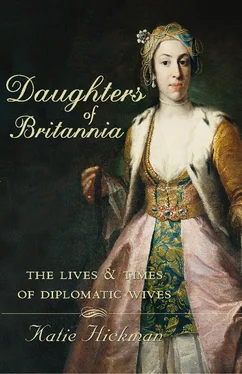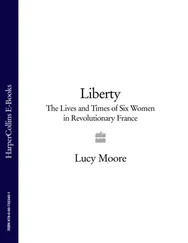It was the dress restrictions that Norah Errock remembers from her lonely diplomatic childhood in Saudi Arabia in the early 1940s. When she and her mother went to visit the King’s harems in Riyadh she was expected to wear Arab clothes. ‘We had sort of bloomers first, then a long shift dress, then a sort of overdress with huge sleeves which you sort of pulled round and that acted as the veil if any male appeared – but in very beautiful colours. And if you went out you put on a black overdress – but then again the overdress was often beautifully embroidered.’ On one occasion Norah’s mother decided that it would be a good idea to show some films to the women.
They had never seen films before. The only films we had of course were propaganda films. I was given instructions on how to run the projector. They were allowing some of the younger princes in, and there was one who kept saying, ‘You should have your veil on when I’m in the room.’ He was probably about eight or so, but he might well have been thirteen and by then, of course, women are supposed to veil in front of them. So I can remember trying to work the machine, and at the same time keep the veil over my face.
The film they enjoyed most was when the previous person who had used the machine hadn’t wound back the reel as you are supposed to do. It was of parachutists and there was this wonderful sequence of the parachute going up – to them of course it was probably just as extraordinary as parachutists coming down from the sky.
Just occasionally a climate, a landscape, a people and a way of life all combined so harmoniously that, even from the very first, a country seemed like nothing short of an earthly paradise. ‘Whatever life brings or takes away … whatever comes, Japan will always be my second home,’ Mary Fraser was to write of her posting there in the 1890s. ‘I do not think I have really been so far from Japan that I did not sometimes see the cherry blossoms drifting on the wind, did not sometimes hear the scream of the wild goose through the winter sky and hear the long roll of the surf thundering up on the Atami beaches.’
Mary Fraser was an American brought up largely in Italy. Her parents were wealthy, liberal, cosmopolitan and artistic. Her sculptor father, Thomas Crawford, rented the Villa Negroni in Rome, once the home of Pope Sixtus V. In 1851 Mary was born there. Its stone walls (the masonry was taken from the ancient baths of Diocletian), its vast warren of long galleries and ‘dimly gorgeous rooms’ were the perfect setting from which to absorb the splendours of Rome. As a young girl Mary met the Brownings, the American poets Lowell and Longfellow and, best of all, Edward Lear, who drew pictures for her youngest sister, Daisy, then still just a little child, and wrote poems for her, including ‘Manyforkia Spoonfoolia’, inspired by the strange meats and unmanageable cutlery of his hotel dining room, and most of the recipes for Nonsense Cookery.
How Mary came to marry the spartan Scot Hugh Fraser we shall never know. They met and became engaged in Venice. Although they seem to have been rather ill-matched, she always wrote of him affectionately. ‘I always leave my real self in cold storage when I go to England,’ she once confessed, ‘and my dear Hugh had very little use at any time for the Mediterranean born side of my personality.’ *
After her first posting to China Mary travelled to Vienna and South America. A photographic portrait of her shows a thin, thoughtful woman with a gentle face and pale blue eyes. Her hair is worn in the style of Queen Alexandra, piled up on the back of her head, a few curls swept carefully over her brow. It was this Mary, older and more wistful, who accompanied her husband, Hugh, when he was sent as minister to Tokyo in 1889.
From the beginning, Mary was bewitched by the beauty of Japan. With its gardens and its cherry blossom, Tokyo was one of the fairest cities she had ever seen: its streets and houses ‘seemed to have grown up by accident – and are of no importance as compared with the flowers.’ In her house, with its wisteria-sheltered verandas and its view, across a little moat, of the Emperor’s new palace, she felt at the very centre of things. Her own upstairs balcony was ‘so wide and cool that every breeze sweeps through it from end to end, and yet so sheltered that I can wander about and work or read in absolute privacy’. Japan seemed ‘absolutely fresh’; ‘All that one has read or heard fails to give any true impression of this vivid youngness,’ Mary wrote. Although she still missed her own country, she felt immediately at home.
Outwardly Mary’s life was still dominated by her diplomatic duties, particularly by the ceremonial of the imperial court; but she was becoming increasingly absorbed by the natural world around her. The plum blossom, ‘eldest brother of the hundred flowers’, came out when the snow was still on the ground, and she was entranced to find that a whole body of poetry and tradition had grown up around this early harbinger of spring. By the beginning of February the plum-gardens were in full bloom, and Mary visited them to admire what the Japanese called the ‘silver world’: ‘a world with snow on the paths and snow on the branches, while snowy petals, with the faintest touch of glow-worm green at the heart, go whirling along on the last gust of wind from the bay’.
In the autumn, it was the maple trees. ‘The autumn has come at last, and the maples are all on fire,’ she wrote in November that year. ‘Since one autumn, when I wandered through the New Jersey woods as a tiny child, I have never seen such a gorgeous explosion of colour, such a storm of scarlet and gold.’ The Japanese sub-divided their maples again and again, and one Japanese gardener told her that he knew of no less than 380 distinct varieties.
Those which please me most are, I think, the kind which grow about ten or twelve feet high, with leaves in five or seven long points, exquisitely cut, and growing like strong fingers on a young hand. They always seem to be pointing to something, and one involuntarily looks round and about to see what it is. They are deep red in colour all the year round, and are constantly grouped with vivid greens, making splendid masses in the shrubberies.
But Mary’s greatest rapture was saved for the cherry blossom. That first spring, the arrival of this fabled wonder coincided with a royal visit from the Duke and Duchess of Connaught. ‘I hope you will not think me wanting in loyalty.’ Mary wrote to her family, ‘if I say that they have been almost more of an excitement to me than the royal visitors.’ Mary had been ill, and the contemplation of the flowers in her garden, particularly the cherry blossom, meant more to her than if she had been up and busy: ‘The crown of the year has come at last … an outburst of bewildering beauty such as no words can convey to those who have not seen it for themselves.’
On the streets of Tokyo every avenue was planted with cherry trees in long, close-set rows; every garden boasted its carefully nurtured groves. ‘Over the river at Mukojima they dip to the water, and spread away inland like a rosy tidal wave; and the great park at Uyeno seems to have caught the sunset clouds of a hundred skies, and kept them captive along its wide forest ways.’ The double cherry blossoms were the most magnificent of all, surpassing ‘every other splendour of nature’. During the two weeks or so when the blossom was at its best, the Japanese flocked, day after day, to look at them. From her veranda Mary watched the tall grove of cherry trees in the garden, their branches waving softly against the sky, storing up ‘the recollection of their loveliness until the next year should bring it round again’.
However, ‘I would not want you to think that existence is one long series of cotillion figures out here,’ she wrote in a more sombre mood; ‘it can be very sad and very bitter.’ At times there was an almost mystical quality to her response to the natural world – her ‘cherry blossom metaphysics’, as she liked to call it, which in her dark moments brought great solace. On her frequent travels around Japan the merest glimpse of Mount Fuji – or Fuji-san, the name reverently given to the perfectly cone-shaped, snow-capped volcano – was usually enough to lift her spirits and banish her lingering sense of disappointment with life. ‘In Japan one cannot think of Fuji as a thing, a mere object in the landscape;’ she mused, ‘she becomes something personal, dominating, a factor in life. No day seems quite sad or aimless in which one has had a glimpse of her.’
Читать дальше












